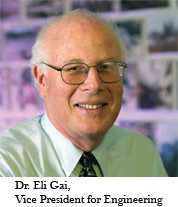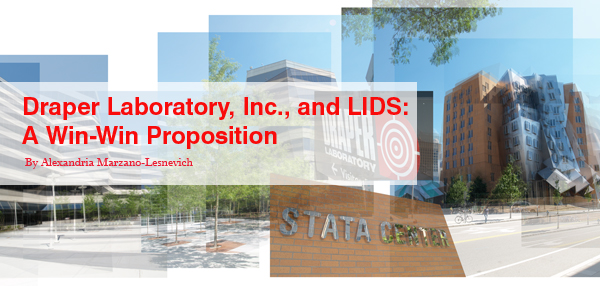Across MIT, Draper Laboratory plays a crucial part in providing students and faculty with the resources they need through the Draper Fellows program. Together with MIT faculty, Draper handpicks Fellows for funding and research support from the pool of admitted MIT graduate students. One such student is Sameera Ponda, a Draper Fellow who is currently finishing her M.S. thesis on mission planning for small unmanned aerial vehicles with Dr. Emilio Frazzoli, an Associate Professor of Aeronautics and Astronautics and member of LIDS. Ponda’s research is representative of Draper’s strongest connections to MIT. “The two main units Draper works with at MIT are Aero and LIDS,” says Dr. Gai.
It is neither an accident nor a surprise that Draper is so deeply entwined with MIT and with LIDS in particular. In fact, Draper Laboratories began life as part of MIT. In 1928, Dr. Charles Stark Draper became a professor of aeronautical engineering at MIT after completing his graduate work here. In addition to researching aircraft engineering, Dr. Draper was a civilian pilot, a hobby he acquired in order to gain insight into the practical applications of his research. It also made him increasingly interested in developing new instruments for navigation. Knowing the strength of the people who surrounded him at MIT, Dr. Draper decided to put his colleagues and students to work on these navigational tools and founded the MIT Instrumentation Lab in the 1930s. For forty years the Lab flourished. It provided the United States military with such crucial innovations as the highly accurate inertial navigation system for ballistic missiles. It also conducted groundbreaking work for NASA, most notably, the Apollo program. The onboard guidance, navigation, and control systems it designed safely guided astronauts on the first trip to the moon in 1969. As tremendous as this progress was for the United States space program, the late 1960s also brought political unrest to the Lab. With the advent of the Vietnam War, the Lab’s focus on developing technology with military applications raised ideological dilemmas about the scope and purpose of university research among students and faculty alike; major concerns about possible use of scientific and technical knowledge in the context of the war effort were being brought to the fore. “There were daily demonstrations on the MIT campus,” Dr. Gai says. “The students didn’t like the Instrumentation Lab to be involved with the war, and the faculty didn’t like approving dissertations [that might be associated with the controversial war effort].” Still, the research the Lab was conducting and the opportunities it afforded MIT students were too valuable simply to shut down. A compromise was struck: the Instrumentation Lab would cease to be a part of MIT, and would instead become an independent, not-for-profit research laboratory to be named after its founder, Dr. Draper. The new Laboratory would remain on MIT’s campus for the time being, but would no longer have any formal affiliation with the University. To continue the relationship, however, its employees would be able to use University facilities in exchange for an annual fee to be paid by the Lab. The Laboratory was so successful that it soon outgrew its MIT location. In 1975, Draper moved off campus into its own sprawling headquarters in Technology Square, where it stands today.
Because it was no longer housed on university grounds, however, the move prompted another dramatic change. Owing to the sensitive nature of much of the research conducted in its labs and the need for security clearances, Draper Research Fellows were now required to be United States citizens for Draper to be able to compete for government contracts. This meant that Draper could no longer support foreign students on its own contracts. But decades of affiliation with MIT had taught the Laboratory something—the strength of any institution lies in its people. Draper didn’t want to lose the ideas MIT’s foreign students had, and it didn’t want to leave the students at a disadvantage for funding to carry out their research. Draper decided to take $2 million from its own funds and give grants to MIT faculty members so they could sponsor their students’ research on campus without concern for nationality. It continues this generous funding today, giving away one percent of its revenue in grants each year. Such creative cooperation, Dr. Gai says, is just one example of how extensive the relationship between the two organizations is, and how much both sides benefit. Draper brings money in to MIT, he notes, a crucial concern for any academic institution. Its close proximity to the campus also indirectly expands the breadth of MIT’s research facilities, as the university doesn’t have to replicate the laboratories that are literally available just down the street. In terms of the actual research, Dr. Gai says, “Draper gives students and faculty the chance to do hands-on work, not just theoretical studies. The reason why Doc Draper actually founded the [Instrumentation] Lab to begin with was to give faculty and students the chance to do customer-relevant work.” Draper gets something important from the relationship, too. “We have access to the best students at MIT,” Gai says, “and therefore the best potential employees.” The influx of new students and new professors means a constant infusion of fresh ideas to fuel Draper’s storied push toward innovation. “Some of Draper’s biggest achievements are based on theses by MIT students,” Dr. Gai says, such as a “fault tolerant parallel processor” that’s been further developed for use by NASA’s Crew Launch Vehicle.
Such successes make it easy to understand why Dr. Gai is so excited about future collaborations between Draper and MIT—and LIDS in particular. “From a theoretical point of view, LIDS is probably the closest laboratory to what we are doing,” Dr. Gai says. An expanded relationship between Draper and LIDS will, Dr. Gai believes, make Draper even more competitive as it redoubles its efforts to win more government contracts. And more contracts for Draper means more opportunities for MIT students. “It’s a win-win situation. Everybody benefits.” With this outcome in mind, Dr. Gai has been taking time out of his busy schedule to talk with LIDS faculty and students about research opportunities at Draper Laboratories. “Instead of [LIDS] just responding to Draper’s needs [for research] in an ad-hoc fashion, we will work year-round on that relationship,” he says. Dr. Gai was an invited speaker at the 2007 LIDS Student Conference, and more recently he and his Draper colleagues have been meeting with LIDS faculty at weekly lunches, where he explains the new thrust of Draper’s collaboration with LIDS. He hopes to align efforts between the two organizations, possibly structuring a joint team that would compete for contracts in areas as diverse as signal processing, networking, human-computer collaboration, and communications. “We need [LIDS],” Dr. Gai says. “And we feel they need us.”




